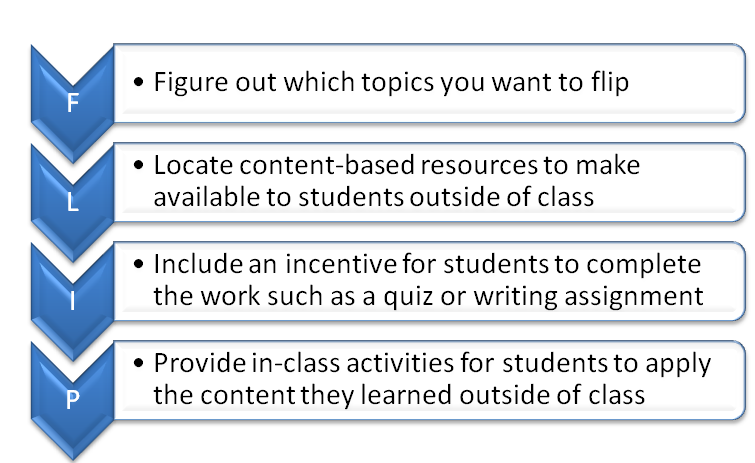Flipped Classroom
The idea behind flipped classroom is that you assign work for students to complete before the topic is “covered” in class. This student work may involve watching an online lecture (yours or someone else's), completing a reading assignment, or studying something you’ve posted for them. Class time is used in a way in which students apply the information they learned about outside of class. The reason it’s termed flipped classroom is that the content is delivered outside of class time instead of through a typical classroom lecture.
The literature reports that students will do the work outside class, but they must be incentivized in some way. One way to do this is to give a quiz on the content when students arrive to class. Another way is to have students complete a worksheet or short writing assignment about the material. Once the assessment in done, class time is used DOING something to apply the material. For example, students may debate an issue, work in teams to complete a project, work on problems, or design something related to your discipline. The instructor is there to help students as they work through the hands-on activity.
For more information about flipped classroom, watch this 60 second video.
These are four easy steps to flip your classroom:

One key thing to remember is that you do not have to flip your entire course. Choose a few topics to flip to get your feet wet. Once you get more comfortable, you can begin to expand the flipped approach.
For more information about using technology for flipping, read this short informational piece by Will Stern, HHP faculty.
Visit this webpage on flipped classroom for a number of resources to get you started.
Resources
7 Things You Should Know About Flipped Classrooms (EDUCAUSE Learning Initiative, February 2012).
- Provides an introduction to flipped instruction, including benefits, drawbacks, and implications for teaching and learning.
- https://www.educause.edu/research-and-publications/7-things-you-should-know-about.
âReverse Instruction Tools and Techniques, Part I,â K. Walsh (EmergingEdTech, February 5, 2012).
- An article about the tools and methods for flipped teaching: Slideshare, Google Docs, Wikis, Course Management Systems and Learning Management Systems.
- http://www.emergingedtech.com/2012/02/reverse-instruction-tools-and-techniques-part-1/
TED Ed: Lessons Worth Sharing.
- This âTED-Ed Tourâ video shows the teaching potential of the hundreds of videos on this site, including ways to customize those on the site or design âflipped classesâ using any video from YouTube.
- https://ed.ted.com/